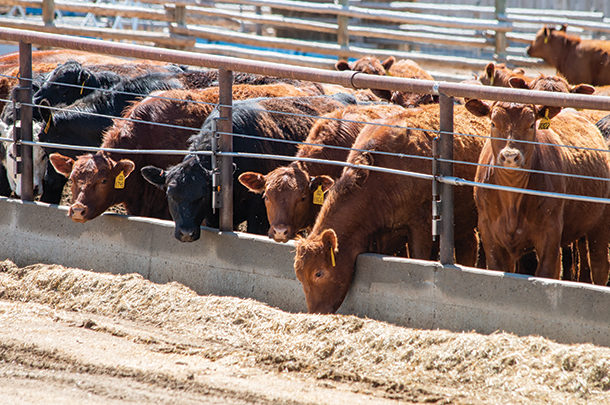Nutritional inadequacies and digestive disorders in beef cattle can result in poor animal health, lowered production and even animal losses. But proper nutrition and management can play a significant role in preventing many feedlot diseases and digestive dysfunctions. A high-quality, nutrient-dense ration – in conjunction with a proper step-up program and good bunk management – can support and strengthen the immune system, overcome challenges encountered in the field and reduce pulls by avoiding respiratory and digestive dysfunctions.
Respiratory dysfunctions
Bovine respiratory disease (BRD) is the most common and costly disease affecting the cattle industry in North America. According to the Beef Cattle Research Council, BRD accounts for 65% to 80% of the morbidity (sickness) and 45% to 75% of the mortality (deaths) in some feedlots. Also known as “shipping fever,” this disease is most prominent in the first few weeks of arrival and affects the upper or lower respiratory tract, causing infection in the lungs which can lead to pneumonia.
Common symptoms to look out for include difficulty breathing, nasal discharge, fever, coughing or loss of appetite. For decades, the beef industry has tried to move benchmarks in cattle health and mortality. Unfortunately, despite new and improved antibiotics and improved management strategies, these benchmarks haven’t budged. Although technology has gotten better, the truth of the matter is: BRD has not. BRD-related deaths have actually increased in the past 10 to 15 years as shown by National Animal Health Monitoring System data in Figure 1.

While BRD is the number one disease in feedlot cattle, research has shown that the right nutrition is an essential factor in helping to avoid this costly ailment. Getting cattle on a proper diet is crucial for them to receive the energy, protein, vitamins and minerals they need to feed their immune system. If cattle aren’t consuming the nutrients they need, their immune system will suffer.
A robust rumen microbiome is a critical and sometimes overlooked factor. Rumen microbes are responsible for the fermentation that makes energy available to the animal, as well as the synthesis of microbial protein and essential vitamins. They also have the ability to help detoxify harmful compounds within the diet. All of this means improved nutrient availability to help support immune strength as well as performance.
Be sure you are also practicing appropriate feedbunk management, as this plays a role as well. Bring cattle up slowly and remember: Consistency is key. Feed managers strive to deliver fresh, nutritious and consistent rations to cattle to optimize intake and sustain animal growth and performance. However, poor feedbunk management can result in decreased dry matter intake (DMI), reduced daily gain and, ultimately, lost production and revenue.
Considerations related to feedbunk management include feed mixing, feed processing, ingredient quality, ration balancing and feed delivery decisions. To prevent poor bunk management, proper protocols need to be in place and followed. This means delivering the right amount of feed at the right time.
Minimizing variation in feed delivery promotes stable rumen fermentation, which ultimately maintains rumen health, improves feed efficiency and reduces production costs. If protocols like these are not in place, poor bunk management can lead to several digestive disorders including acidosis and liver abscesses.
Success in every type of beef operation builds on a foundation of good nutrition and rumen health. In order to combat some of these challenges, work with your nutritionist to incorporate an in-feed immune support product. With the right immune support product, your cattle have a better chance of overcoming challenges, improving immune function, optimizing rumen and liver health, and maintaining consistent feed intake.
A more robust and resilient rumen environment leads to more available nutrients, a better balance of VFAs and a more stable rumen pH. This generates better animal performance and less incidence of subacute rumen acidosis (SARA). Outcomes of a stronger immune function include improved immunity, thus lessening disease risk, especially BRD. This leads to fewer pulls and lower treatment costs.
Digestive dysfunctions
Two of the most common digestive dysfunctions in beef cattle tend to be bloat and acidosis. Bloat occurs when there is a buildup of carbon dioxide gas in the rumen. Immediately after cattle consume feed, the digestive process creates these gases, and most are eliminated by eructation – belching. In certain situations, trapped gases cannot be belched and may form a foam or froth in the rumen. In severe cases, this can lead to death.
With bloat being a big issue, especially in natural – or ionophore-free – feedyards, one beneficial approach is to incorporate an immune support and rumen health product. In fact, a summary of research conducted by the Universitat Autonoma of Barcelona, Spain, examined the effects of yeast culture supplementation on rumen microbial fermentation and indicators of bloat in heifers. In this study, foam height and foam strength, the amount of time it took the foam to disappear, were measured (Figures 2 and 3).


The results showed foam height was numerically decreased by nearly 7%, but that foam strength was significantly decreased by over 62% in heifers receiving a Saccharomyces cerevisiae fermentation product (SCFP) compared to control heifers. These findings demonstrate the potential effect of a rumen and immune support product on reducing the risk of bloat caused by high-starch diets.
Another digestive dysfunction to keep in mind is acidosis. Acidosis generally means an acidic rumen pH caused by too much rapidly fermentable carbohydrates or too little fiber. It occurs when the rumen microbes produce more acid than what can be used.
This situation can result in a cascade of events such as the death of some rumen microbes and a shift in the microbial balance. With subclinical acidosis, cattle might be a bit acidotic, but you can’t see it in their behavior or on the feed records. However, it can still result in suppressed digestibility and performance, as well as liver abscesses. Byproduct feeds such as distillers grains and corn gluten feed can be a great tool for helping reduce acidosis and liver abscesses.
However, do not be too complacent just because you are using these feedstuffs. High distillers or gluten diets are not 100% guaranteed and can still be an issue. To reduce the risk of acidosis, establish and implement feedbunk management protocols, maintain rumen health by ensuring consistent feed intake, guarantee feed in the bunk matches the ration on paper (TMR audit) and feed products that create the right rumen microbial balance.
Good nutrition, proper feedbunk management and incorporating a rumen and immune support product all play a pivotal role in preventing feedlot diseases and disorders. Encompassing all three can lead to healthier animals, higher production and, ultimately, greater profits.









